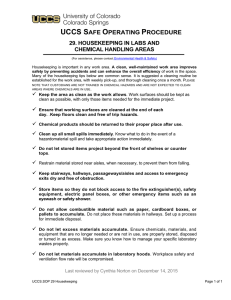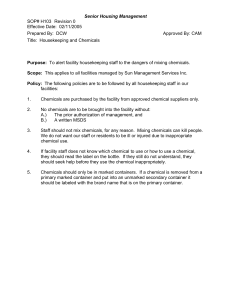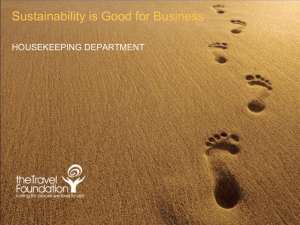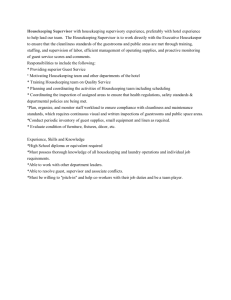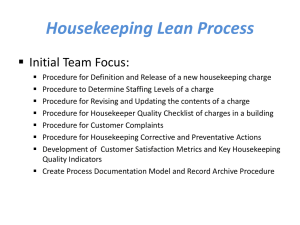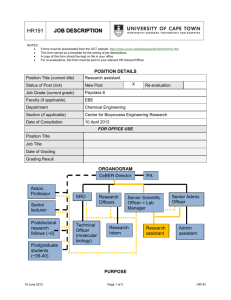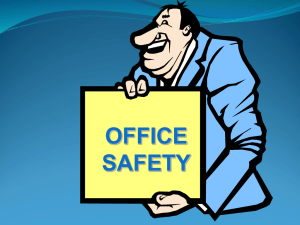1 - Louisiana State University
advertisement
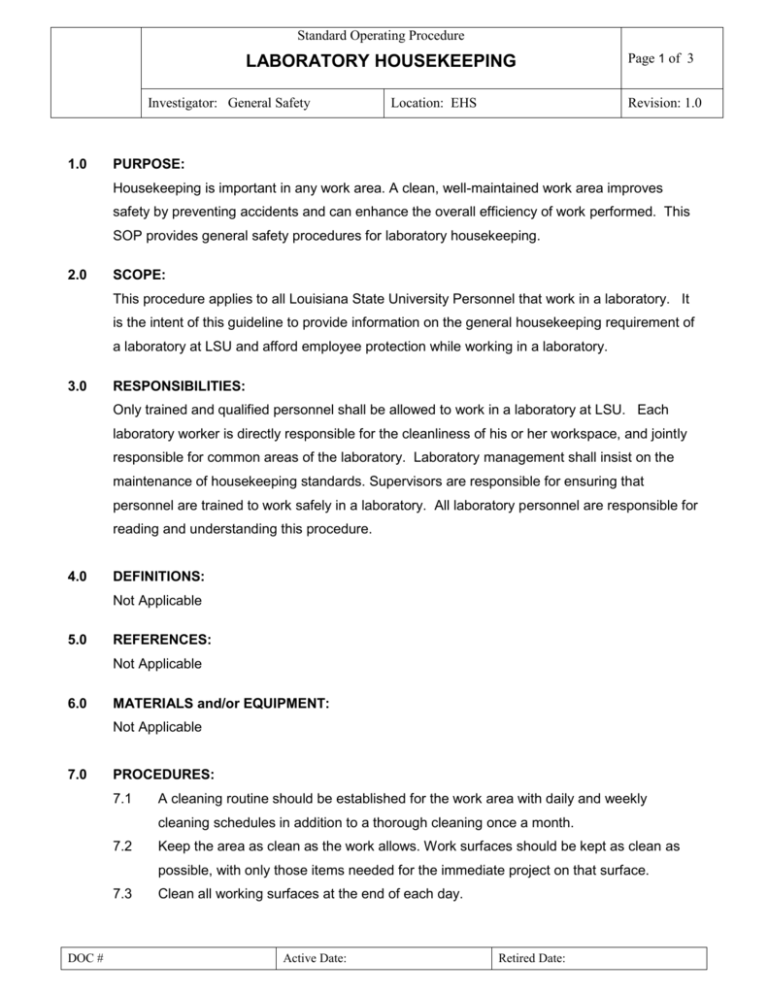
Standard Operating Procedure LABORATORY HOUSEKEEPING Investigator: General Safety 1.0 Location: EHS Page 1 of 3 Revision: 1.0 PURPOSE: Housekeeping is important in any work area. A clean, well-maintained work area improves safety by preventing accidents and can enhance the overall efficiency of work performed. This SOP provides general safety procedures for laboratory housekeeping. 2.0 SCOPE: This procedure applies to all Louisiana State University Personnel that work in a laboratory. It is the intent of this guideline to provide information on the general housekeeping requirement of a laboratory at LSU and afford employee protection while working in a laboratory. 3.0 RESPONSIBILITIES: Only trained and qualified personnel shall be allowed to work in a laboratory at LSU. Each laboratory worker is directly responsible for the cleanliness of his or her workspace, and jointly responsible for common areas of the laboratory. Laboratory management shall insist on the maintenance of housekeeping standards. Supervisors are responsible for ensuring that personnel are trained to work safely in a laboratory. All laboratory personnel are responsible for reading and understanding this procedure. 4.0 DEFINITIONS: Not Applicable 5.0 REFERENCES: Not Applicable 6.0 MATERIALS and/or EQUIPMENT: Not Applicable 7.0 PROCEDURES: 7.1 A cleaning routine should be established for the work area with daily and weekly cleaning schedules in addition to a thorough cleaning once a month. 7.2 Keep the area as clean as the work allows. Work surfaces should be kept as clean as possible, with only those items needed for the immediate project on that surface. 7.3 DOC # Clean all working surfaces at the end of each day. Active Date: Retired Date: Standard Operating Procedure LABORATORY HOUSEKEEPING Investigator: General Safety 7.4 Location: EHS Page 2 of 3 Revision: 1.0 All apparatus(s) shall be thoroughly cleaned and returned to storage upon completion of usage. 7.5 Keep floors clean and free of tripping hazards. 7.6 Chemical containers shall be clean, properly labeled and returned to storage upon completion of usage. Labels shall face front. Store flammable liquids in a flammable liquids cabinet. Do not store acids above shoulder height or in unprotected metal cabinets. Store water reactive materials away from water sources, such as sprinkler systems and sinks. 7.7 Maintain a chemical inventory. Store only the amount of material reasonably needed. Do not over-purchase. 7.8 Replace chemicals that have reached their expiration date. 7.9 Date peroxide forming chemicals with the date received and the date opened. See SOP Use and Storage of Peroxide-forming Chemicals. 7.10 Do not store frequently used or heavy items on top shelves. Locate supplies used daily close to the work area and place items used periodically on nearby storage areas. See SOP Laboratory Ergonomics and Laboratory Ergonomics – Workbenches. 7.11 When storing items on shelves, the top of the items should be greater than 18” from the ceiling to ensure adequate coverage by sprinkler heads in the event of a fire. 7.12 Shelves should be equipped with doors or lips to prevent items from falling. 7.13 Do not let stored items project beyond the front of shelves or counter tops. Restrain material stored near aisles, when necessary, to prevent them from falling. Always restrain compressed gas cylinders. 7.14 Keep an adequately stocked spill kit in the work area. Clean up all small spills immediately. Know what to do in the event of a hazardous material spill and take appropriate action immediately. 7.15 Keep stairways, hallways, passageways/aisles and access to emergency exits dry and free of obstruction. 7.16 Store items so they do not block access to the fire extinguisher(s), safety equipment, electric panel boxes, or other emergency items such as an eyewash or safety shower. 7.17 Do not allow combustible material such as paper, cardboard boxes, or pallets to accumulate. Do not place these materials in hallways. Set up a process for immediate disposal or filing of items. DOC # Active Date: 02/10/11 Retired Date: Standard Operating Procedure LABORATORY HOUSEKEEPING Investigator: General Safety 7.18 Location: EHS Page 3 of 3 Revision: 1.0 Do not let materials accumulate. Ensure materials, chemicals, and equipment that are no longer needed, are disposed of properly or turned in as excess. Know how to manage laboratory wastes properly. 7.19 Do not let materials accumulate in laboratory hoods. The safety of this workspace and the ventilation provided is compromised when excessive chemicals and equipment are kept in this space. 7.20 Ensure that proper collection containers for biohazards, sharps, and paper trash are placed near the point of use and are adequate of size. 7.21 Do not over fill collection receptacles. 7.22 Ensure that all wastes that are not general refuse (e.g., radioactive, chemical, and biohazardous wastes) are prominently labeled and that staff are trained not to remove these materials from the lab. 7.23 Chemical wastes will be disposed of in accordance with the waste disposal plan. 7.24 Faculty and principle investigators should informally conduct housekeeping and chemical hygiene inspections continually. 8.0 CONTINGENCIES: In case of a fire, explosion, or gas leak evacuate individuals from the area and call the emergency response (911). Observe appropriate procedures for personal injury or fire as provided in EHS Web site. 9.0 REVIEWS AND REVISIONS: This procedure shall be reviewed for compliance and effectiveness and revised as necessary on an annual basis. 10.0 ATTACHMENTS and REFERENCE FORMS: Not Applicable DOC # Active Date: 02/10/11 Retired Date:
